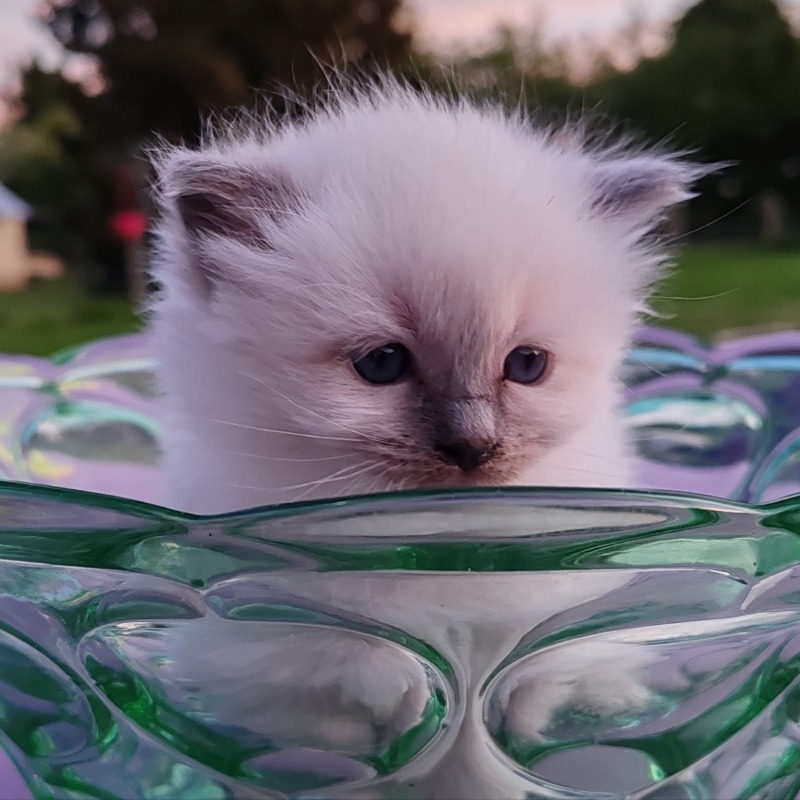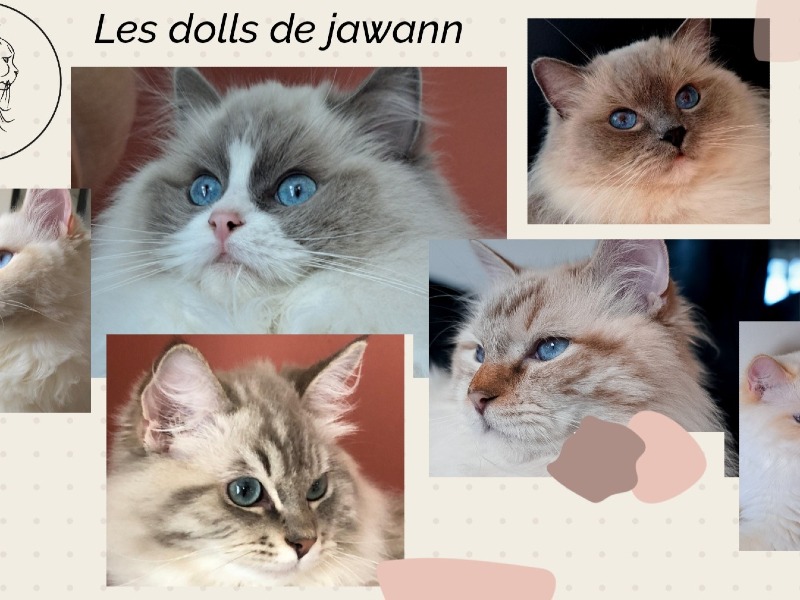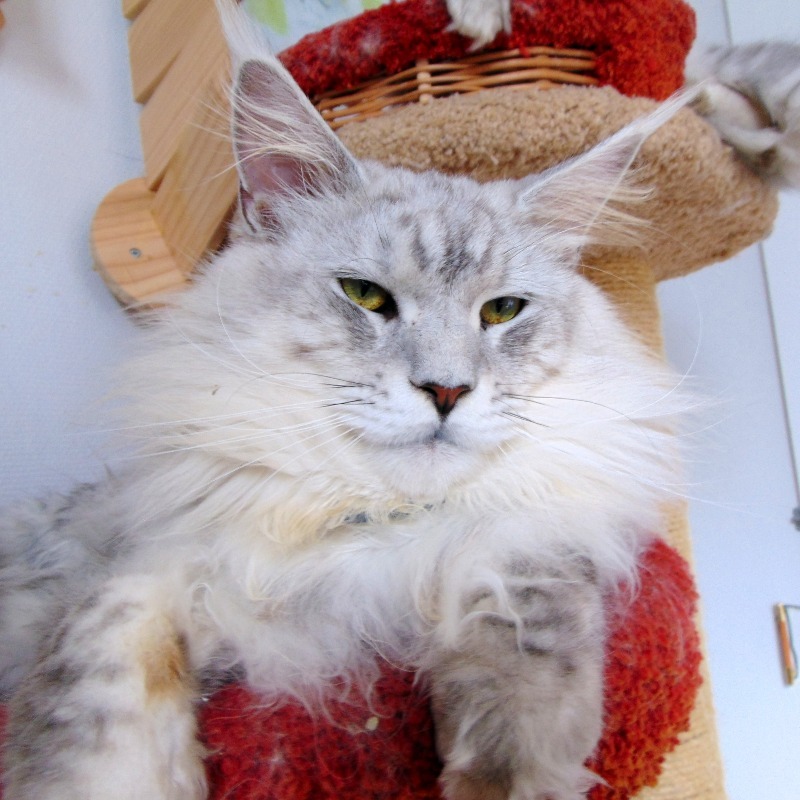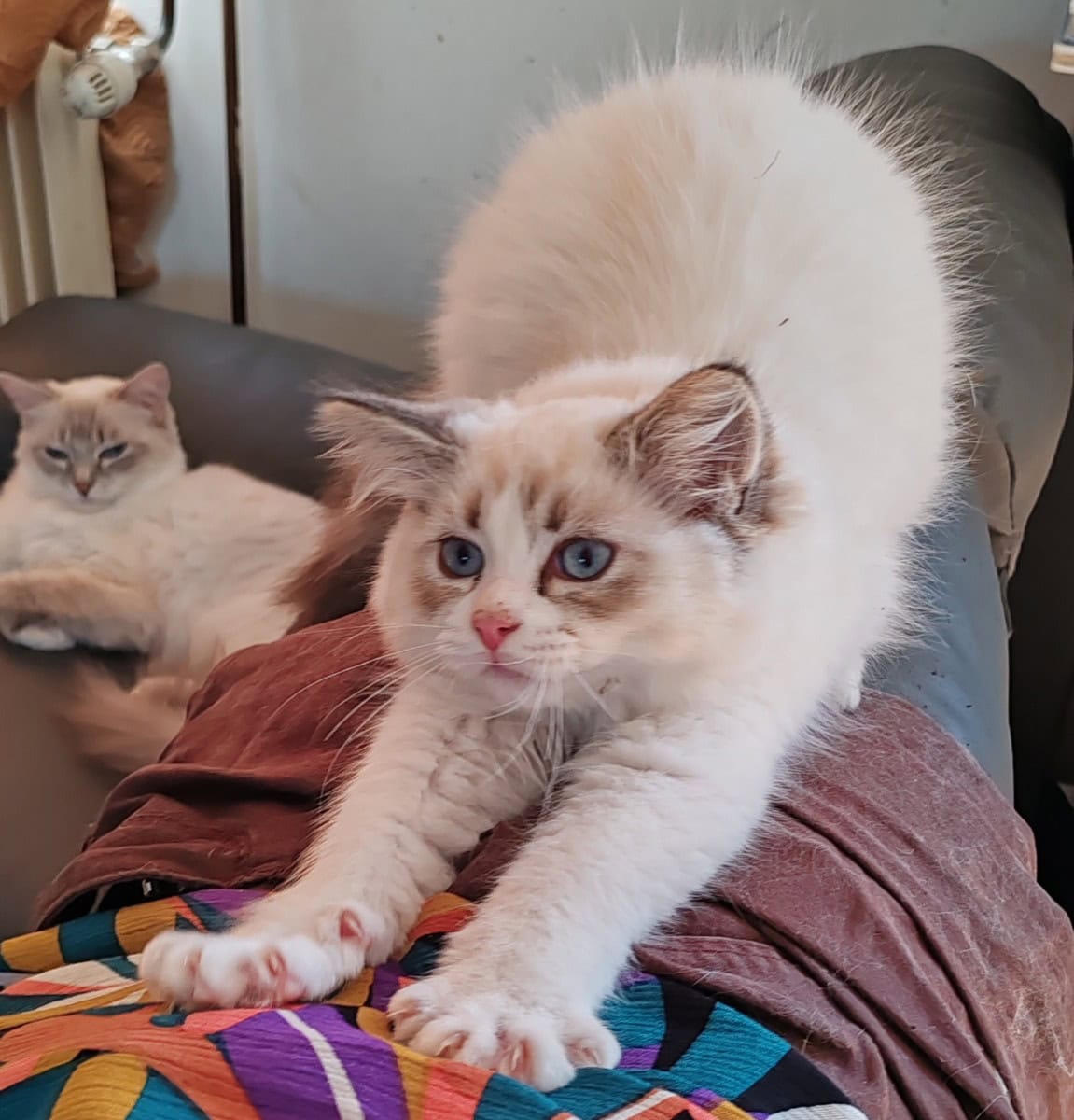Ragdoll
Discover the Ragdoll, a cat breed renowned for its gentleness, affectionate nature, and luxurious coat. Learn all about its distinctive traits, needs, and how to integrate it harmoniously into your home.
Awareness of acquiring an animal
Adoption and breeding of cats should always be guided by a sincere attachment to the animal and an understanding of its specific needs. Whether for leisure or passion, it is essential to provide a safe, enriching, and suitable environment. Avoid any impulsive acquisition that could harm their well-being. Cats require attention, regular healthcare, and a secure space. Commit to providing them with a quality life by being a conscientious and informed owner or breeder.
To learn more about animal welfare, we invite you to consult our FAQ by clicking the button below:
Origins and history
The origins of the Ragdoll cat breed date back to the 1960s in California, when a breeder named Ann Baker began working on this new breed. She crossed several long-haired cats with a gentle and affectionate temperament. The first Ragdolls were descended from a cat named Josephine, a long-haired female with a calm character. The breed's distinctive characteristics, such as their silky fur and almond-shaped eyes, were carefully selected by Ann Baker.
The history of Ragdolls is marked by a commitment to developing a cat with a docile and playful temperament. These felines are distinguished by their tendency to completely relax when held, which gives them the reputation of being "floppy dolls." Starting in the 1970s, the breed began to gain popularity, both in the United States and internationally.
Ragdolls quickly became sought-after pets, prized for their loving and sociable nature. Today, they are one of the most beloved cat breeds, often alongside other companion breeds. Their presence in cat shows and recognition by various cat associations have solidified their place in the hearts of feline enthusiasts.
Physical characteristics
The Ragdoll is a cat breed recognized for its majestic appearance and distinctive physical characteristics. One of the most striking traits is its large size. Males often weigh between 5 to 9 kg, while females are slightly smaller, typically ranging from 4 to 7 kg. Their sturdy bone structure contributes to their impressive strength.
The coat of the Ragdoll is another essential aspect of this breed. It is semi-long, silky, and soft to the touch, lacking the fluffy texture found in other breeds. Their fur is generally of a light color and features colored patterns, often with darker points on the extremities (paws, face, ears, and tail), creating a striking contrast. Their eyes are large, almond-shaped, and a deep blue, adding to their gentle and docile expression.
Finally, the head of the Ragdoll is wide and rounded, with full cheeks and a slightly upturned nose. Their body, with powerful, muscular legs, enhances their imposing appearance while also bestowing undeniable grace. These characteristics make them not only attractive animals but also highly valued for their sweet and affectionate personality.
Character
The Ragdoll is a cat breed renowned for its gentle and affectionate temperament. These felines are often described as companionship magnets, seeking closeness to their owners. Their tender nature makes them ideal companions for families, including those with children or other pets. They enjoy a close bond with their masters and are often seen following them from room to room.
Another distinctive trait is their calmness. Ragdolls are generally composed cats that are not easily disturbed by noisy or chaotic environments. This tranquility makes them suitable for indoor living, as they adapt well to changes in routine. They often prefer quiet interactions, enjoying cuddle sessions and gentle playtime.
Additionally, these felines are very sociable. They do not like to be alone for long periods and prefer company, whether it's that of their owners or other animals. They are known for their curiosity and playful nature, which drives them to explore their surroundings enthusiastically. These characteristics make the Ragdoll a favored choice for those seeking a friendly and devoted presence.
Life expectancy
The life expectancy of a breed of cats is an important factor for prospective owners to consider. For this particular breed, the average lifespan generally ranges from 12 to 15 years. However, some individuals may live longer, sometimes reaching 18 years or more, thanks to proper care and a good quality of life.
Longevity depends on several factors, including genetics, diet, environment, and veterinary care. A balanced diet tailored to the specific needs of the breed, along with regular access to veterinary care, plays a crucial role in maintaining health. It is also advisable to keep these animals primarily indoors, which can protect them from infectious diseases and accidents.
Furthermore, this breed is generally considered robust, but it may be prone to certain hereditary health conditions, such as heart diseases. Regular check-ups by a veterinarian can help detect and address any potential health issues promptly, thus contributing to a longer, healthier life.
Exercise and activity needs
Ragdoll cats are known for their sweet and friendly nature. Although they are often described as "indoor cats," it is essential to provide them with some form of exercise and activity to ensure their physical and mental well-being. These felines adapt well to a sedentary lifestyle, but they still require regular interactions.
One of the keys to keeping a Ragdoll healthy is to provide stimulating toys. Games that encourage hunting, such as laser pointers or plush mice, are perfect for awakening their natural hunting instinct. Regular play sessions, lasting about ten to twenty minutes several times a day, are recommended to burn off their energy.
Additionally, access to climbing posts or cat trees allows for varied activities while promoting exercise. These structures are ideal for climbing, observing, and resting. Mental stimulation is equally essential. Interactive toys and puzzle games help prevent boredom, which is crucial for this breed that can easily become lazy. In summary, while Ragdolls enjoy their tranquility, regular engagement in diverse activities is fundamental to their balance and happiness.
Recommended diet
The diet for Ragdoll cats must be carefully balanced to support their health and well-being. Due to their size and nature, these cats have specific energy needs that must be taken into account. A diet rich in high-quality protein is essential, as protein plays a key role in muscle development and maintaining a healthy coat.
Carbohydrates should also be included, but in moderation, as Ragdolls tend to be more sedentary compared to other breeds. It is preferable to prioritize sources of complex carbohydrates, such as brown rice or sweet potatoes, which provide sustained energy without causing spikes in blood glucose.
Hydration is another crucial aspect of their diet. It is advisable to provide fresh water at all times and to consider adding wet food to their diet, as this helps maintain good hydration and contributes to urinary health.
It is recommended to consult a veterinarian to determine the specific nutritional needs of each cat, as age, weight, and physical activity influence nutrient requirements. A tailored diet promotes a long and healthy life for Ragdolls.
Training and obedience
The training and education of a Ragdoll cat require a gentle and patient approach. These animals are known for their placid and docile nature, which makes learning easier. It is essential to start the education process at a young age. The initial lessons should include simple commands like "come" or "sit," which can be taught using rewards. Treats and petting are very effective for reinforcing desired behaviors.
Playtime plays a fundamental role in the education of these cats. Using interactive toys helps stimulate their intellect and strengthens the bond between the animal and its owner. These playful moments also promote learning about cleanliness, a crucial aspect for good cohabitation. It is advisable to have a clean and accessible litter box to encourage good habits.
Finally, it is important to establish a calm and predictable environment. Ragdolls are sensitive to sudden changes, which can disrupt their progress. Creating a reassuring routine helps them adapt and feel more secure in their space. With love and patience, educating this breed can be a rewarding experience.
Behavior with children
Cats of this breed are often praised for their gentle temperament and affectionate nature, making them particularly well-suited to family life with children. Their calm and sociable behavior encourages positive interaction, allowing children to feel safe and comfortable with them. They are generally patient and tolerant, which helps create a warm and welcoming environment.
Additionally, these felines are known for their tendency to bond with their humans. They enjoy spending time near children, easily integrating into family activities. This sociability allows them to become ideal play companions, enjoying cuddles and strokes. Their playful nature stimulates the imagination of the younger ones, who can have fun playing with them while learning the responsibility of caring for a pet.
However, it is important to supervise interactions between children and these cats, particularly to avoid rough behaviors from the little ones. By creating a safe play space and teaching children to respect the animal's boundaries, a harmonious relationship is fostered. Thus, this breed can contribute to a joyful and balanced home, reinforcing family bonds through its calming presence and unconditional affection.
Compatibility with Other Animals
Ragdoll cats are known for their gentle and affectionate temperament, making them generally compatible with other pets. Their calm and sociable nature often allows them to get along with dogs, cats, and even other types of animals. When introducing a Ragdoll into a household already populated with other pets, it is important to do so gradually and monitor the initial interactions.
Ragdoll cats are often curious and playful, which helps them easily integrate into lively environments. Their friendly and non-aggressive attitude can help soothe more nervous animals. It is advisable to ensure that there are retreat spaces for each pet so they can rest and distance themselves if needed. This helps reduce stress and promotes harmonious coexistence.
In summary, Ragdolls can live alongside other pets, as long as certain introduction and adaptation rules are followed. Their sociable nature makes them ideal companions for families with multiple animals. Proper attention and care will ensure a beautiful harmony in the household.
Grooming needs
Grooming and care for Ragdoll cats are essential to ensure their well-being and health. Due to their long, silky fur, regular brushing is recommended to prevent matting and reduce shedding. Ideally, it is advised to brush their coat at least two to three times a week. This not only helps keep their fur in good condition but also stimulates blood circulation in the skin.
As for bathing, Ragdolls do not need frequent baths. Generally, a bath every few months is sufficient, unless they find themselves in a situation where they get particularly dirty. It is essential to use a gentle shampoo specifically designed for cats to maintain the quality of their coat.
Lastly, it is important to ensure general hygiene. Their claws should be trimmed regularly, and their ears cleaned to prevent any infections. Regular veterinary visits for health check-ups will also help keep Ragdolls in good condition. By following these care guidelines, you can ensure a healthy and fulfilling life for these affectionate companions.
Health
The Ragdoll cat breed is appreciated for its gentle and affectionate temperament, but certain health concerns should be taken into consideration. First of all, these cats are predisposed to heart problems, particularly hypertrophic cardiomyopathy, a condition where the heart muscle thickens, potentially leading to serious complications. Regular veterinary check-ups are recommended to monitor their heart health.
Another important aspect is their vulnerability to kidney diseases. Ragdolls can develop hereditary kidney issues, which underscores the importance of preventive screening. A balanced diet and constant access to fresh water are crucial for maintaining kidney health.
Finally, Ragdolls may also be prone to dental problems and obesity due to their rather sedentary nature. It is essential to encourage active play and practice regular dental care to prevent these issues. In summary, being vigilant about their overall health will help ensure the well-being of these affectionate cats.
Environment and habitat
The Ragdoll is a cat breed known for its gentle and affectionate temperament. Its ideal environment should be enriched to promote its well-being and flourishing. Therefore, it is important to have a sufficiently spacious area, as this breed does not like to feel cramped. A spacious apartment with multiple rooms or a house with access to a secure garden is perfectly suited.
Ragdolls are social animals that thrive on human companionship. They should live in an environment where they can regularly interact with their owners. Playtime and interaction are crucial for their emotional development. Incorporating various toys, cat trees, and climbing spaces will help stimulate their curiosity and natural instincts.
Regarding the climate, Ragdolls can adapt to various conditions, but it is essential to ensure that the environment remains temperate. Avoid extreme temperatures and make sure they have access to cool areas in the summer and warm spots in the winter to ensure their comfort. Special attention to their hygiene, particularly through regular grooming, is also vital to prevent coat and skin issues.
Name ideas
Choosing a name for a cat is an essential step that can reflect its personality, appearance, or even your own sensitivities. For the Ragdoll breed, known for its affectionate nature and beauty, it's wise to select a name that evokes these traits. A good name should be easy to pronounce, memorable, and align with the gentle and calming nature of this breed. Names inspired by nature, fictional characters, or emotions can be particularly relevant.
When selecting a name, also consider how it will sound when calling the cat. A soft sound may suit a cat that loves to be comforted, while a more lively name might match a playful cat. It’s also interesting to take the color of their fur into account, as this can inspire creative choices.
Here are some suggestions: Céleste, Moka, Poussin, Lumière, Nuage, Vanille, Azur, Saphir, Tendre, Biscuit, Mélodie, Émeraude, Douceur, Seraphine, Étoile. These names highlight the affectionate and delicate side of Ragdolls while being easy to remember.
Average purchase price
The prices for purchasing a Ragdoll cat can vary significantly depending on several factors. Generally, a kitten of this breed can cost between €800 and €2,500. This price range depends on various elements such as the breeder’s reputation, the quality of the lineage, and specific characteristics of the kitten, such as coat color and pattern.
Reputable breeders who are dedicated to the improvement of the breed and the well-being of the animals tend to ask for a higher price. Additionally, kittens from champion bloodlines or those exhibiting highly sought-after traits can reach the highest prices on the market. There are often additional costs involved, including vaccinations, pedigree registration, and sometimes even spaying or neutering.
Finally, it is important to consider the ongoing expenses associated with owning a cat. Food, veterinary care, and toys represent regular investments that should be taken into account in the overall budget of a prospective owner.
Expenses
When owning a Ragdoll cat, it is essential to carefully plan your monthly expenses to ensure its well-being. On average, these costs can vary depending on several factors, but one can estimate a monthly expenditure of around 80 to 150 euros.
Food expenses make up a significant portion of the budget. A cat requires high-quality nutrition, and specialized kibble or wet food can cost between 30 and 60 euros per month. It is advisable to choose appropriate products to ensure the health and vitality of the animal.
Regular veterinary expenses, including vaccinations and routine check-ups, should also be taken into account. These appointments can cost between 15 and 30 euros monthly if annual costs are spread out. Additionally, pet health insurance can range from 10 to 25 euros per month, providing peace of mind against unexpected situations.
Finally, don’t forget the expenses related to accessories and care. This includes litter, which can amount to around 10-20 euros per month, as well as other items like toys, scratching posts, and hygiene products.
In summary, owning a Ragdoll cat requires a well-thought-out monthly budget that encompasses dietary needs, veterinary care, and various expenses to ensure a fulfilling life for your companion.
Destination and usage
Ragdolls are highly prized as pets due to their gentle and affectionate temperament. These cats are known for their sociable nature and their ability to form close bonds with their owners. They easily integrate into various households, whether they involve families with children, couples, or single individuals. Their calm disposition makes them perfect companions for those seeking a soothing animal.
Another common use of this breed is their ability to live harmoniously with other animals. Ragdolls are generally friendly towards dogs and other cats, making them suitable for homes where multiple pets cohabit. Their easygoing temperament and curiosity help them adapt to new environments, making them pleasant companions even in dynamic households.
Additionally, ragdolls are often chosen for their attractive physical appearance. Their soft, silky fur, along with their large, expressive eyes, makes them visually appealing pets. This contributes to their popularity in homes where affection and human interaction are paramount. In short, these cats represent an excellent choice for those seeking a loyal and loving companion.
Legislation and regulation
Legislation and regulations regarding the Ragdoll cat breed vary significantly from country to country. In many places, there is no specific legislation governing the ownership or breeding of this breed. However, animal protection organizations may impose ethical standards for breeding, aiming to ensure the health and well-being of the animals.
In some European countries, strict regulations on the breeding of specific breeds are in place to combat irresponsible breeding practices. This includes registration requirements with recognized organizations and adherence to health standards. Breeders often must prove that their practices meet health criteria to avoid common hereditary diseases within the breed.
In North America, while the legislation is generally less stringent, shelters and organizations encourage responsible adoption and support for ethical breeders. Discussions around legislation often focus on promoting adoption and spaying/neutering to address animal overpopulation. Thus, existing laws often aim to balance the preservation of breeds with the protection of animal rights.
Official recognition
The Ragdoll is a breed of cat that has gained popularity since its creation in the 1960s. Official recognition of this breed varies by country and feline organizations. In the United States, the Ragdoll was recognized by the Cat Fanciers' Association (CFA) in 2000, which contributed to its fame on the continent. Other organizations, such as the International Cat Association (TICA), also grant it recognized status, thereby strengthening its presence in the market.
In Europe, recognition is generally done through national federations. In countries like France and the United Kingdom, feline associations such as the Livre Officiel des Origines Félines (LOOF) and the Governing Council of the Cat Fancy (GCCF) have included this breed in their registry. This allows breeders to certify the lineage of cats and organize shows where Ragdolls can be judged.
In other regions of the world, recognition may be less systematic. In Asia, for example, the popularity of the Ragdoll is increasing, but its official status can vary significantly from country to country. Therefore, it is essential for prospective owners and breeders to check local regulations and recognition bodies to ensure compliance and the well-being of the animals.
Pedigrees
To obtain a pedigree for Ragdoll cats, several organizations and clubs are responsible for the registration of cats and the management of pedigrees. These entities play an essential role in preserving breed standards and promoting good breeding practices.
One of the most important is the International Cat Federation (FIFe), which establishes standards for cat breeds, including Ragdolls. This organization ensures that registered cats meet specific breed criteria, thereby ensuring their genetic purity. Breeders affiliated with FIFe can obtain pedigree certificates for their cats.
Another recognized club is the Cat Fanciers' Association (CFA), which is one of the largest and most influential in the world. The CFA also offers official recognition for Ragdoll cats and provides a registration system to establish the lineage of the animals.
TICA, or The International Cat Association, also focuses on this breed and offers similar registration services. Registered breeders can access services that allow them to document the genealogy of their Ragdoll cats.
Finally, many national clubs may offer registration and lineage verification services, thus contributing to the traceability of Ragdolls within different regions. These options are crucial for ensuring the health and quality of cats of this breed.
Prohibitions
The prohibitions concerning certain breeds of cats, such as the Ragdoll breed, vary considerably from country to country. In many areas, this breed is widely accepted and appreciated for its docile temperament and affectionate appearance. However, some legislation may restrict the ownership of certain species of cats for reasons related to animal welfare or biodiversity protection.
In certain countries, regulations govern the breeding and sale of specific breeds, including health and selection requirements. For example, quality of life standards for pets may include restrictions on the number of animals that can be bred or the necessity of presenting health certificates. This aims to prevent abuse in breeding and to ensure that animals are raised in appropriate conditions.
On the other hand, some areas have introduced restrictions on breeds deemed more problematic due to their specific needs or behavior. However, the Ragdoll breed, generally recognized for its calm temperament, is not often included among those subject to prohibitions. It is therefore crucial for potential owners to inquire about local legislation to ensure responsible adoption.
Breeders of Ragdoll
Want to see more breeders of Ragdoll?
Check out the page of our directory listing all breeders of RagdollClassified Ads of Ragdoll
Breed clubs of ragdoll
No of ragdoll breed clubs are currently registered on Preeders.
If you would like to highlight your breed club, sign up for free now and be the first to appear on this page.






